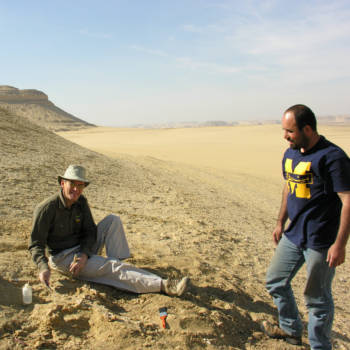From Architecture to AI-Powered Building Diagnostics: Tarek Rakha’s start-up story
10 June 2025
Published online 11 December 2019
Fossilised remains of a newly identified species of whale found in Egypt represent the evolutionary step from foot-powered to tail-powered swimming.

© Philip Gingerich
Now, Philip Gingerich at the University of Michigan, US, together with Mohammed Antar at the Egyptian Environmental Affairs Agency in Cairo, and Iyad Zalmout of the Saudi Geological Survey in Jeddah, have described fossils of the Aegicetus gehennae species, which they discovered at the Wadi Al Hitan World Heritage Site – or ‘Valley of the Whales’ - in Egypt in 2007.
“We’ve found hundreds of 'basilosaurid' fossil whales at Wadi Al Hitan before; basilosaurids lived during the late Eocene and were the first fully tail-powered whales,” says Gingerich. “But we had never found evidence of more primitive whales at that location, so we were really excited when we unearthed two specimens of protocetid whales, dating to around 35 million years old.”
One of the fossils, a male, which would have been around 3.6 metres long and weighed 890 kilograms in life, was nearly complete. This in itself is a rare find, as many fossils are poorly preserved when they are unearthed. The discovery of another partial skeleton allowed the team to verify their new species.
“Our whale has an elongated body and tail with large ‘hands’, and crucially, its small back legs have no firm connection to the long, powerful spinal column,” says Gingerich. This suggests it was a swimmer who could not hold its own weight on land. “We believe it swam with an undulating motion of its mid-body and tail, rather like a modern eel or crocodile. It was definitely less of a foot-powered swimmer than its ancestors.”
“Aegicetus gehennae is a wonderfully complete representative of a late protocetid,” says Ryan Bebej, a biologist at Calvin University in Michigan, US, and an expert in early whales. “This new fossil gives us unprecedented details of forelimb, hind limb, and vertebral anatomy, providing us with valuable insights into the locomotor capabilities of cetaceans during this crucial stage of their land-to-sea transition. It will also generate new ideas about how these mammals became increasingly adapted for moving efficiently in the water.”
Gingerich is continuing his work on the Egyptian whale fossils, and is collaborating with colleagues in Morocco and Peru on related early whales.
doi:10.1038/nmiddleeast.2019.163
Gingerich, P.D., Antar, M.S.M., & Zalmout, I.S. Aegicetus gehennae, a new late Eocene protocetid (Cetacea, Archaeoceti) from Wadi Al Hitan, Egypt, and the transition to tail-powered swimming in whales. PLOS ONE 14 (12) e0225391 (2019).
Stay connected: